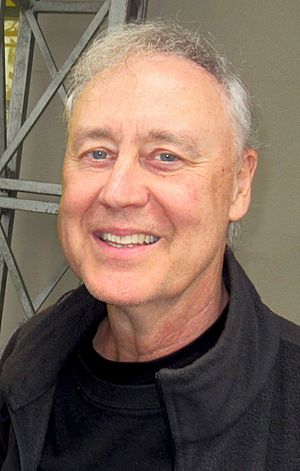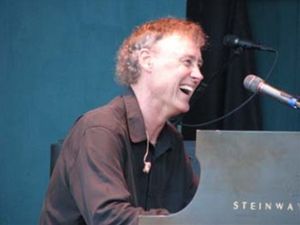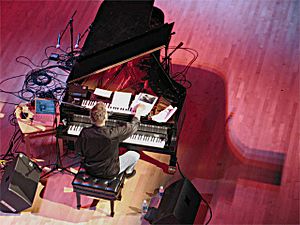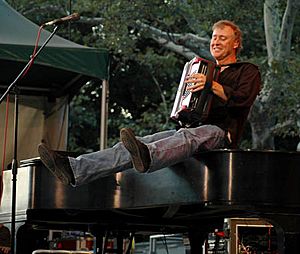Bruce Hornsby facts for kids
Quick facts for kids
Bruce Hornsby
|
|
|---|---|

Hornsby in 2019
|
|
| Background information | |
| Birth name | Bruce Randall Hornsby |
| Born | November 23, 1954 Williamsburg, Virginia, U.S. |
| Genres | Rock, gospel, heartland rock, jazz, bluegrass, blues rock |
| Occupation(s) | Singer, musician |
| Instruments |
|
| Years active | 1974–present |
| Labels | RCA, CBS/Sony, Sony BMG, Vanguard, Sire |
| Associated acts | Bruce Hornsby Trio, Grateful Dead, Jerry Garcia, Ricky Skaggs, Bob Weir, Dave Matthews Band, Sting, Ambrosia, Jack DeJohnette, Jackson Browne, Eric Clapton, Huey Lewis, Bonnie Raitt, The Other Ones, Bob Dylan, Don Henley, Hall & Oates, Bon Iver, Ezra Koenig |
Bruce Randall Hornsby (born November 23, 1954) is an American singer, songwriter, and piano player. His music mixes many styles like folk rock, jazz, bluegrass, folk, Southern rock, country rock, jam band, rock, and blues rock.
Hornsby has won three Grammy Awards. He won one in 1987 for Best New Artist with his band, Bruce Hornsby and the Range. He won another in 1990 for Best Bluegrass Recording, and a third in 1994 for Best Pop Instrumental Performance.
Bruce Hornsby has played with his touring band, Bruce Hornsby and the Noisemakers. He also has a bluegrass project with Ricky Skaggs. He has worked as a guest musician for many other artists. From September 1990 to March 1992, he was a touring member of the famous band Grateful Dead, playing over 100 shows with them.
His 23rd album, Flicted, was released in May 2022.
Contents
Early Life and Musical Start
Bruce Randall Hornsby was born in Williamsburg, Virginia. His father, Robert Stanley Hornsby, was a lawyer and real estate developer who also played music. His mother, Lois, was a piano player. Bruce has two brothers, Robert Saunier "Bobby" Hornsby and John Hornsby. John has written songs with Bruce.
Bruce finished high school in Williamsburg in 1973. He played on the basketball team there. He then studied music at the University of Richmond, Berklee College of Music, and the University of Miami, where he graduated in 1977.
In 1974, Bruce's older brother Bobby formed a band called "Bobby Hi-Test and the Octane Kids." Bruce played piano and sang in this band. They played songs by bands like Allman Brothers Band and Grateful Dead.
After college in 1977, Hornsby played music in clubs and hotel bars in his hometown. In 1980, he and his brother John moved to Los Angeles to write songs for 20th Century Fox. Bruce also worked as a musician for other artists. In 1982, he joined the band Ambrosia for their last album.
Bruce Hornsby made a demo recording of his songs "Mandolin Rain" and "The Way It Is." This led to him signing with RCA Records in 1985.
Forming The Range
|
Bruce Hornsby and the Range
|
|
|---|---|
| Origin | Los Angeles, California/Williamsburg, Virginia, United States |
| Genres | Rock, pop rock, soft rock |
| Years active | 1984–1991 |
| Labels | RCA Records |
| Past members | Bruce Hornsby David Mansfield George Marinelli Joe Puerta John Molo |
In 1984, Bruce Hornsby started his band called Bruce Hornsby and the Range. They signed with RCA Records in 1985. The band members were Bruce Hornsby (piano, vocals), David Mansfield (guitar, mandolin, violin), George Marinelli (guitars, backing vocals), Joe Puerta (bass guitar, backing vocals), and John Molo (drums).
Bruce Hornsby's first big hit was "The Way It Is". It became number one on the Billboard Hot 100 chart in December 1986. The song talked about important topics like homelessness, the American civil rights movement, and institutional racism. Many rap artists, including Tupac Shakur, have used parts of this song in their own music.
The album The Way It Is sold millions of copies. It also included "Mandolin Rain", another top-five hit that Bruce wrote with his brother John. "Every Little Kiss" reached number 14 on the Billboard Hot 100 in July 1987. The album helped create what some called the "Virginia sound," which mixed rock, jazz, and bluegrass. Bruce Hornsby and the Range won the Grammy Award for Best New Artist in 1987.
The band's music was known for Bruce's piano solos, which had a special rhythm. They also used many synthesizers to create background sounds for his solos.
| Bruce Hornsby timeline | |
|---|---|
| 1984–1991 | Bruce Hornsby and the Range |
| 1990–1992 | Grateful Dead |
| 1993–1995 | Solo Albums: Harbor Lights & Hot House |
| 1996–1998 | Further Festivals & The Other Ones, Solo Album: Spirit Trail |
| 1998–present | Bruce Hornsby and the Noise Makers |
| 2007–present | Ricky Skaggs & Bruce Hornsby |
| 2007–present | The Bruce Hornsby Trio (with Christian McBride & Jack DeJohnette) |
The Range's second album, Scenes from the Southside, came out in 1988. It included "Look Out Any Window" and "The Valley Road". Critics noticed that these songs had "more open" music, which allowed Bruce to play more expressive piano solos. The album also had "Jacob's Ladder", a song the Hornsby brothers wrote for their friend Huey Lewis. Lewis's version became a number one hit.
In the late 1980s and early 1990s, Hornsby worked with many other musicians. He played piano on Don Henley's hit "The End of the Innocence" in 1989. In 1991, he played piano on Bonnie Raitt's hit "I Can't Make You Love Me". He also appeared on albums by Bob Dylan and Eric Clapton.
Bruce started adding jazz and bluegrass sounds to his music. In 1989, he performed at the Telluride Bluegrass Festival. He also remade his song "The Valley Road" with the Nitty Gritty Dirt Band. In February 1990, this song won a Grammy Award for Best Bluegrass Recording.
In May 1990, he released A Night on the Town. On this album, he worked with jazz musicians like Wayne Shorter and bluegrass banjo player Bela Fleck. The album had more rock and guitar sounds, with Jerry Garcia playing guitar on several songs. Bruce Hornsby and the Range started playing longer, more free-flowing songs in their concerts. After a final tour in 1991, Bruce decided to end the Range to explore new musical styles.
Playing with the Grateful Dead
In 1988, Bruce Hornsby first played on stage with the Grateful Dead. This became a regular thing until the band stopped playing. Hornsby was often a guest before becoming a regular member of their touring band a few years later.
From 1988 until Jerry Garcia passed away in 1995, Hornsby played over 100 shows with the Grateful Dead. After the Grateful Dead's keyboard player Brent Mydland passed away in July 1990, Hornsby played piano and accordion at many of their concerts.
Playing with the Grateful Dead changed Hornsby's music a lot. The Grateful Dead were known for mixing folk music and blues with psychedelic rock in long, free-form jams. This helped Hornsby explore music beyond pop. Critics also noticed a strong musical connection between Hornsby and Jerry Garcia. Hornsby's jazz-inspired playing added to the band's sound and helped Garcia's guitar solos. Hornsby's ability to play many styles and join in long jams made him popular with Grateful Dead fans.
Since playing with the Grateful Dead, Hornsby's concerts have attracted many "Deadheads" (Grateful Dead fans). He often plays some of their songs at his shows. Hornsby originals like "The Valley Road" were also played by the Grateful Dead.
Hornsby was the person who introduced the Grateful Dead when they were put into the Rock and Roll Hall of Fame in 1994. He continues to work on projects related to the Grateful Dead, like with Bob Weir's band Ratdog. He also played with The Other Ones in 1998 and 2000. In July 2015, Hornsby reunited with the living members of the Grateful Dead for special concerts.
Solo Music Journey

Bruce Hornsby released his first solo album, Harbor Lights, in 1993. This album showed his music leaning more towards jazz. It featured famous musicians like Pat Metheny, Branford Marsalis, Jerry Garcia, Phil Collins, and Bonnie Raitt. Hornsby won his third Grammy Award in 1993 for Best Pop Instrumental for "Barcelona Mona," a song he wrote with Branford Marsalis for the Barcelona Olympics.
In 1995, Hot House was released. The album cover showed a imagined jam session between bluegrass musician Bill Monroe and jazz saxophonist Charlie Parker. Hornsby continued his jazz sound from Harbor Lights but also brought back bluegrass elements from his earlier work.
| "To be creative, spontaneous in the moment and make music in the present tense, that's what we're all about live. I write the songs, we make the records and then the records become a departure point, the basic blueprint, the basic arrangement. I'm fairly restless creatively. I was never a very good Top 40 band guy because I never liked to play the same thing every time. Too often songwriters approach their songs like museum pieces. I don't subscribe to that. I think of my songs as living beings that evolve and change and grow through the years." |
| —Bruce Hornsby |
During this time, Hornsby's concerts became more relaxed and fun. He started taking song requests from the audience. His performances became chances for him to challenge himself by mixing different musical styles together.
In 1998, Hornsby released a double album called Spirit Trail. This album featured instrumental songs and storytelling, mixing rock, jazz, and other styles he had explored. The album explored themes about the American South, including "songs about race, religion, judgment and tolerance." An example is "Sneaking Up on Boo Radley," which refers to a character from the famous novel To Kill a Mockingbird.
Over these solo albums, Hornsby's piano playing became more complex. He started doing solo piano shows for the first time in his career. These shows allowed him to blend classical music, jazz, bluegrass, folk, and Grateful Dead songs with his own music. Hornsby said these solo tours helped him improve his piano playing to a "whole new level."
In August 2014, Hornsby released his first album that was entirely live solo performances, called Solo Concerts.
In April 2019, his 21st album, Absolute Zero, was released. It included collaborations with artists like Justin Vernon of Bon Iver and Jack DeJohnette.
The Noisemakers Band
Hornsby's touring band changed a lot between 1998 and 2000. His longtime drummer John Molo joined another band. Bruce started experimenting with a different sound, working with musicians like Steve Kimock on guitar. A new band, called the Noisemakers, began to form. In 2000, Hornsby released a live album called Here Come the Noise Makers with his new band. The Noisemakers included John "J.T." Thomas (keyboards), Bobby Read (saxophones, woodwinds), J.V. Collier (bass), Doug Derryberry (guitar, mandolin), and later Sonny Emory on drums.

In 2002, Hornsby released Big Swing Face. This album was his most experimental. He barely played any piano on it, and it used a lot of electronic beats and synthesizers. The album received mixed reviews.
In 2004, after many years with RCA Records, Hornsby signed with Columbia Records. His first album with Columbia, Halcyon Days, released in June 2004, returned to a more acoustic, piano-focused sound. Famous guests on this album included Sting, Elton John, and Eric Clapton.
In July 2006, Hornsby released a four-CD/DVD box set called Intersections (1985–2005). This set included many previously unreleased songs and live versions of his hits. One new song, "Song H," was nominated for a Grammy Award in 2007.
In 2007, Hornsby started playing classical music more often in his concerts. He would sometimes play parts of J.S. Bach's Goldberg Variations during his improvisations.
On September 15, 2009, Bruce Hornsby and the Noisemakers released their fourth album, Levitate. In May 2011, the band released a live album, Bride of the Noisemakers.
On June 17, 2016, Bruce Hornsby and the Noisemakers released Rehab Reunion. On this album, Hornsby played the dulcimer instead of the piano. It featured guest artists like Justin Vernon of Bon Iver and Mavis Staples. The album also included a folk version of "The Valley Road."
Collaborations and Other Projects
In March 2007, Hornsby worked with bluegrass musician Ricky Skaggs to create a bluegrass album called Ricky Skaggs & Bruce Hornsby. They then went on tour together. The album mixed bluegrass, traditional country music, jazz piano, and humor. It included new songs and a bluegrass version of Hornsby's hit "Mandolin Rain." The album even ended with a bluegrass version of Rick James's funk hit "Super Freak"! The album reached number one on the Billboard Bluegrass Albums list. The duo released a live album, Cluck Ol' Hen, in September 2013.
At the same time, Hornsby recorded a jazz album called Camp Meeting with Christian McBride (bass) and Jack DeJohnette (drums). The trio played new versions of songs by jazz legends like John Coltrane and Miles Davis, along with Hornsby's own songs. They performed at major jazz festivals in 2007.
Hornsby has also worked on many projects with filmmaker Spike Lee. He composed and performed music for several of Lee's films, including Clockers (1995), Bamboozled (2001), Kobe Doin' Work (2009), Red Hook Summer (2012), Old Boy (2013), Chi-Raq (2015), and BlacKkKlansman (2018).
In 2014, Hornsby toured with the Pat Metheny Unity Group. In 2016, he performed on a Grateful Dead cover album called Day of the Dead. He also performed with Justin Vernon at Coachella in 2017.
Musical Instruments
Hornsby mainly uses a Steinway & Sons concert grand piano for his performances. Before 1995, he used a Baldwin concert grand piano. He also uses a Korg M1 synthesizer. For his 2016 album Rehab Reunion, he played an Appalachian dulcimer.
Personal Life
Bruce Hornsby and his wife Kathy have twin sons, Russell and Keith, born in 1992. They were named after musicians Leon Russell and Keith Jarrett. Keith played college basketball for Louisiana State University.
Hornsby loves basketball and often attends college basketball games in Virginia. He is also friends with baseball Hall of Fame manager Tony La Russa. Their friendship led to La Russa introducing Hornsby to jazz bassist Christian McBride, which helped form The Bruce Hornsby Trio.
Awards and Nominations
| Award | Year | Nominee(s) | Category | Result | Ref. |
|---|---|---|---|---|---|
| ASCAP Pop Music Awards | 1988 | "The Way It Is" | Most Performed Songs | Won | |
| 1990 | "The End of the Innocence" | Won | |||
| 1991 | Won | ||||
| Grammy Awards | 1987 | Bruce Hornsby & the Range | Best New Artist | Won | |
| 1990 | "The Valley Road" | Best Bluegrass Recording | Won | ||
| "The End of the Innocence" | Song of the Year | Nominated | |||
| Record of the Year | Nominated | ||||
| 1991 | "Across the River" | Best Pop Performance by a Duo or Group with Vocal | Nominated | ||
| 1994 | "Barcelona Mona" | Best Pop Instrumental Performance | Won | ||
| 1995 | "The Star Spangled Banner" | Nominated | |||
| 1996 | "Song B" | Nominated | |||
| "Love Me Still" | Best Song Written for Visual Media | Nominated | |||
| 2000 | "Song C" | Best Pop Instrumental Performance | Nominated | ||
| 2005 | "Song F" | Nominated | |||
| 2007 | "Song H" | Nominated | |||
| 2009 | "Is This America?" | Best Country Instrumental Performance | Nominated | ||
| MTV Video Music Awards | 1987 | "The Way It Is" | Best New Artist in a Video | Nominated | |
| Pollstar Concert Industry Awards | 1987 | Bruce Hornsby & the Range | Next Major Arena Headliner | Nominated | |
| 1988 | Nominated | ||||
| Tour | Small Hall Tour Of The Year | Won |
Discography
- The Way It Is (1986)
- Scenes from the Southside (1988)
- A Night on the Town (1990)
- Harbor Lights (1993)
- Hot House (1995)
- Spirit Trail (1998)
- Here Come the Noisemakers (2000) (live album)
- Big Swing Face (2002)
- Halcyon Days (2004)
- Greatest Radio Hits (2004) (compilation)
- Camp Meeting (2007)
- Levitate (2009)
- Bride of the Noisemakers (2011) (live album)
- Red Hook Summer (2012)
- Solo Concerts (2014) (live album)
- Rehab Reunion (2016)
- Absolute Zero (2019)
- Non-Secure Connection (2020)
- 'Flicted (2022)
See also
 In Spanish: Bruce Hornsby para niños
In Spanish: Bruce Hornsby para niños


